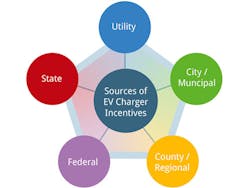EV Charger Rebate Trends for 2023
The electric vehicle revolution is in full swing, with more Americans than ever before looking to make the switch to EVs. As a result, the demand for charging equipment has skyrocketed, creating a very attractive opportunity for EV charging manufacturers, installers and distributors. Fortunately, rebates and incentives have emerged as powerful resources to fund these projects and to make EV charging equipment more accessible to the general public.
2022 saw a flurry of rebate activity, with new programs debuting, existing programs adapting to the changing landscape, and funding levels fluctuating. Now that many of the 2023 rebate programs are in place, it's time to review the rebate and incentive landscape for EV chargers in 2023.
Here are the major trends in the world of EV charger rebates for 2023:
- Most of the United States is covered by an EV charger rebate
- 22% growth in EV charger rebate programs
- Minor changes in EV charger rebate amounts
- Approved lists gain popularity
- Changes in the Federal Tax Credit
#1. Most of the United States is covered by an EV charger rebate
The biggest question regarding EV chargers rebates is, "Do I qualify for a rebate?" Unfortunately, that's a tricky question to answer. A patchwork of programs covers North America, and eligibility can vary depending on geography, user type, the charger used and when it will be installed.
The good news is that even though it's complicated, most of the United States has an incentive available. Currently, 62% of the country is covered by a rebate, incentive or grant for installing an EV charger. That's up 7% from the same time last year, and more new programs are still coming online every day.
The strongest areas are typically the Northeast and West Coast, but generous programs have also popped up in the Midwest and South.
#2. 22% growth in EV charger rebate programs
Rebate programs fall into five different geographic categories: municipal, electric utility, regional/county, state and federal. As a result, programs can overlap. Sometimes you can stack two incentives together, while other times, you must select which program you prefer.
#3. Minor changes in EV charger rebate amounts
Because EV charger rebates are relatively new across the country, no one could predict what would happen to the rebate dollar amounts as many organizations transitioned to their 2023 programs. Generally speaking, though, the incentive amount remained the same.
For a Level 2 residential charger, the average rebate across the US is now $521. That's a 5% increase from last year. For Level 3 / DCFC chargers, the rebate went up by 2% to $31,306 per charger.
Between 2022 and 2023, the average rebate for Level 2 commercial chargers decreased by 14% to $2,013. However, this trend wasn't because of declining rebate amounts of existing programs. Instead, it was because new programs launched with lower incentive amounts that brought down the national average.
Because program funding levels are constantly changing for EV charger rebates, the average amount can swing greatly depending on which programs happen to have funding. For the most part though, the rebate amounts have been pretty stable.
#4. Approved lists gain popularity
Some incentive programs require a project to use a specific charger or network to qualify. The approved lists can vary on a program-by-program basis; they can have as few as two models and as many as a hundred. It's incredibly cumbersome to monitor and more complex than energy efficiency rebate programs, which mostly have a de-facto standard (such as the Design Lights Consortium list for commercial lighting).
In 2022, only about 20% of programs had an approved list. Today, 25% of rebate programs require that the charging equipment is on an approved list. In addition, around 10% of commercial programs require that the equipment is connected to an approved network (an approved network requirement is very rare on the residential side).
When looking to install a charger, one of the first steps is to find out if the local rebate programs require a certain charger or network. While some programs will allow new chargers to be added to the approved list, it will add extra time to the rebate pre-approval process.
#5. Changes in the Federal Tax Credit
The Federal Tax Credit for EV chargers, sometimes referred to as the Alternative Fuel Infrastructure 30C Tax Credit, has been a strong motivator for customers across the entire United States since it debuted in 2005. When the tax credit was renewed in 2022, the government added several new stipulations that severely limited the areas of the country that could apply for it.
One of the biggest changes is that after Jan. 1, 2023, a property must be in an "approved census tract" to be able to claim the tax credit. These areas are essentially non-urban or low-income parts of the country. As a result, projects that would have previously qualified for the credit may no longer be eligible, so be sure to double-check any project you were working on last year.
Until the end of 2022, the tax credit was 30% of the project cost up to $30,000 for commercial properties. Now, the base tax credit is 6%, and if installed following prevailing wage and apprenticeship requirements, that multiplies the tax credit by 5, bringing it to 30% of the project cost. Also, the cap for commercial projects has increased from $30,000 to $100,000.
Summary
EV charger rebates in 2023 are stronger than ever. As the popularity of EVs continues to grow rapidly, it’s likely that governments and utilities will continue to offer rebates and incentives for EV charger installations to make sure that people have enough options to charge their electric vehicles. The landscape is constantly changing, though, so make sure to stay on top of these dynamic incentives.
Lighting industry veteran Leendert Jan Enthoven founded BriteSwitch, Princeton, NJ, in 2008 to help businesses take advantage of the lighting rebate and incentive programs that exist across the U.S. and Canada. The company's Rebate Pro tool now also focuses on EV rebates. To learn more about their expertise in this area, contact him at [email protected] or (609) 945-5349.


